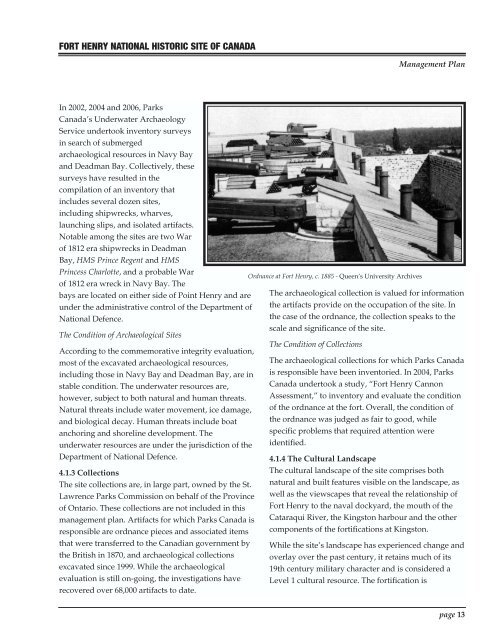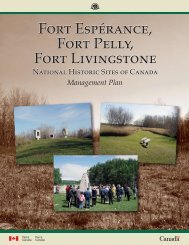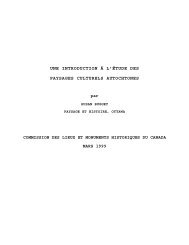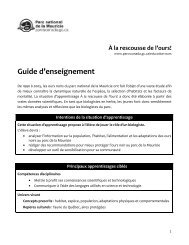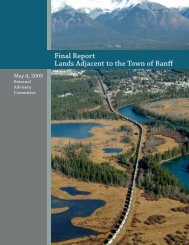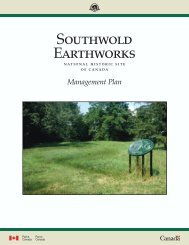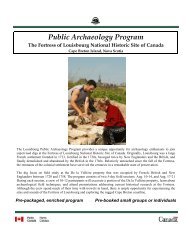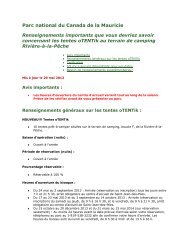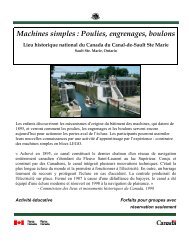Copyright Her Majesty the Queen in Right of Canada
Copyright Her Majesty the Queen in Right of Canada
Copyright Her Majesty the Queen in Right of Canada
Create successful ePaper yourself
Turn your PDF publications into a flip-book with our unique Google optimized e-Paper software.
FORT HENRY NATIONAL HISTORIC SITE OF CANADA<br />
Management Plan<br />
In 2002, 2004 and 2006, Parks<br />
<strong>Canada</strong>’s Underwater Archaeology<br />
Service undertook <strong>in</strong>ventory surveys<br />
<strong>in</strong> search <strong>of</strong> submerged<br />
archaeological resources <strong>in</strong> Navy Bay<br />
and Deadman Bay. Collectively, <strong>the</strong>se<br />
surveys have resulted <strong>in</strong> <strong>the</strong><br />
compilation <strong>of</strong> an <strong>in</strong>ventory that<br />
<strong>in</strong>cludes several dozen sites,<br />
<strong>in</strong>clud<strong>in</strong>g shipwrecks, wharves,<br />
launch<strong>in</strong>g slips, and isolated artifacts.<br />
Notable among <strong>the</strong> sites are two War<br />
<strong>of</strong> 1812 era shipwrecks <strong>in</strong> Deadman<br />
Bay, HMS Pr<strong>in</strong>ce Regent and HMS<br />
Pr<strong>in</strong>cess Charlotte, and a probable War<br />
<strong>of</strong> 1812 era wreck <strong>in</strong> Navy Bay. The<br />
bays are located on ei<strong>the</strong>r side <strong>of</strong> Po<strong>in</strong>t Henry and are<br />
under <strong>the</strong> adm<strong>in</strong>istrative control <strong>of</strong> <strong>the</strong> Department <strong>of</strong><br />
National Defence.<br />
The Condition <strong>of</strong> Archaeological Sites<br />
Accord<strong>in</strong>g to <strong>the</strong> commemorative <strong>in</strong>tegrity evaluation,<br />
most <strong>of</strong> <strong>the</strong> excavated archaeological resources,<br />
<strong>in</strong>clud<strong>in</strong>g those <strong>in</strong> Navy Bay and Deadman Bay, are <strong>in</strong><br />
stable condition. The underwater resources are,<br />
however, subject to both natural and human threats.<br />
Natural threats <strong>in</strong>clude water movement, ice damage,<br />
and biological decay. Human threats <strong>in</strong>clude boat<br />
anchor<strong>in</strong>g and shorel<strong>in</strong>e development. The<br />
underwater resources are under <strong>the</strong> jurisdiction <strong>of</strong> <strong>the</strong><br />
Department <strong>of</strong> National Defence.<br />
4.1.3 Collections<br />
The site collections are, <strong>in</strong> large part, owned by <strong>the</strong> St.<br />
Lawrence Parks Commission on behalf <strong>of</strong> <strong>the</strong> Prov<strong>in</strong>ce<br />
<strong>of</strong> Ontario. These collections are not <strong>in</strong>cluded <strong>in</strong> this<br />
management plan. Artifacts for which Parks <strong>Canada</strong> is<br />
responsible are ordnance pieces and associated items<br />
that were transferred to <strong>the</strong> Canadian government by<br />
<strong>the</strong> British <strong>in</strong> 1870, and archaeological collections<br />
excavated s<strong>in</strong>ce 1999. While <strong>the</strong> archaeological<br />
evaluation is still on-go<strong>in</strong>g, <strong>the</strong> <strong>in</strong>vestigations have<br />
recovered over 68,000 artifacts to date.<br />
Ordnance at Fort Henry, c. 1885 - <strong>Queen</strong>’s University Archives<br />
The archaeological collection is valued for <strong>in</strong>formation<br />
<strong>the</strong> artifacts provide on <strong>the</strong> occupation <strong>of</strong> <strong>the</strong> site. In<br />
<strong>the</strong> case <strong>of</strong> <strong>the</strong> ordnance, <strong>the</strong> collection speaks to <strong>the</strong><br />
scale and significance <strong>of</strong> <strong>the</strong> site.<br />
The Condition <strong>of</strong> Collections<br />
The archaeological collections for which Parks <strong>Canada</strong><br />
is responsible have been <strong>in</strong>ventoried. In 2004, Parks<br />
<strong>Canada</strong> undertook a study, “Fort Henry Cannon<br />
Assessment,” to <strong>in</strong>ventory and evaluate <strong>the</strong> condition<br />
<strong>of</strong> <strong>the</strong> ordnance at <strong>the</strong> fort. Overall, <strong>the</strong> condition <strong>of</strong><br />
<strong>the</strong> ordnance was judged as fair to good, while<br />
specific problems that required attention were<br />
identified.<br />
4.1.4 The Cultural Landscape<br />
The cultural landscape <strong>of</strong> <strong>the</strong> site comprises both<br />
natural and built features visible on <strong>the</strong> landscape, as<br />
well as <strong>the</strong> viewscapes that reveal <strong>the</strong> relationship <strong>of</strong><br />
Fort Henry to <strong>the</strong> naval dockyard, <strong>the</strong> mouth <strong>of</strong> <strong>the</strong><br />
Cataraqui River, <strong>the</strong> K<strong>in</strong>gston harbour and <strong>the</strong> o<strong>the</strong>r<br />
components <strong>of</strong> <strong>the</strong> fortifications at K<strong>in</strong>gston.<br />
While <strong>the</strong> site’s landscape has experienced change and<br />
overlay over <strong>the</strong> past century, it reta<strong>in</strong>s much <strong>of</strong> its<br />
19th century military character and is considered a<br />
Level 1 cultural resource. The fortification is<br />
page 13


